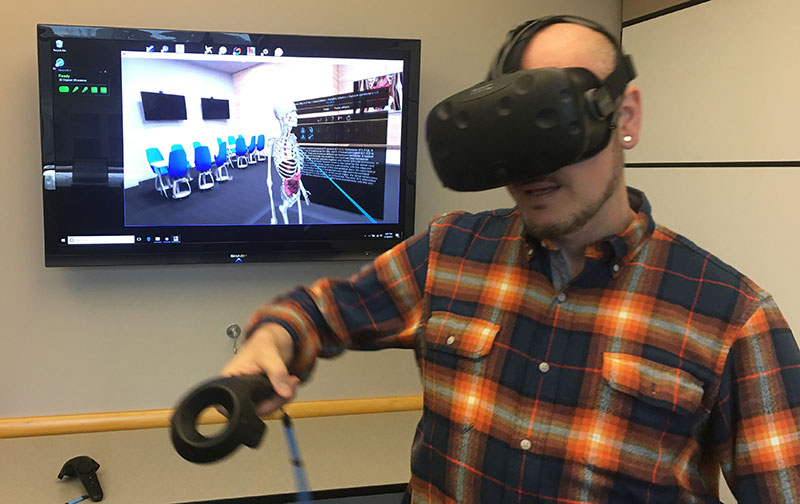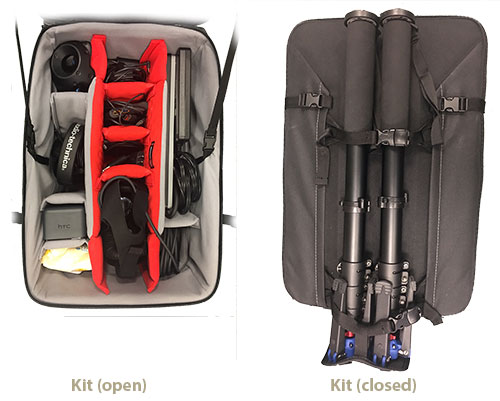Immersive Learning
Immersive learning is the emergence of new and robust learning technologies that use Virtual Reality (VR), Augmented Reality (AR) and 360 (or spherical) video. These technologies can shape and enhance medical education by moving the learning beyond other more static presentations.

VR is emerging as a powerful tool to either visualize and interact with information in three dimensions, or simulate real-life scenarios. At its best, such learning can provide a place for medical learners to practice procedures or techniques before performing them in the hospital or clinic.
AR involves adding a layer of information over real-world experiences in clinical or medical practice.
360 video can be used to bring the learners into new experiences as an observer, particularly in cases where access to an environment may otherwise be challenging or impossible.
All of these technologies allow our learners to experience medical practice in ways they haven't been able to in decades past. This takes our learners even closer towards the competencies they need to master in order to become stellar physicians. We are creating pilots and ways to explore this emerging area to enhance the Bridges Curriculum.
Virtual Reality Demonstrations
We can provide demonstrations on the new emerging technologies for immersive learning. Please contact us if you're interested and would like to know of upcoming opportunities to see this in action.
Our Kits
We often transport a customized kit offsite, which holds all of our equipment for easy and convenient setup. Review Specs for our Virtual Reality Portable Kit, below:
Space Setup Requirements
- Wall-mounted bigscreen monitor. We depend on the presence of one of these in the space we set up in, so that observers can see some of the VR experiencer's field of view shared up on a big screen.
- Space requirements. Min of 5.5 ft X 6 ft; Max of 15 ft X 15 ft.
- Power sources. We are dependent on at least two separate power outlets (base stations must be positioned at opposite ends of the space setup).
Portable Virtual Reality Kit Equipment List
The contents of our virtual reality kit are as follows:
 High-performance PC laptop. This is your most expensive purchase. We use an Alienware gaming laptop (see next category for complete specs).
High-performance PC laptop. This is your most expensive purchase. We use an Alienware gaming laptop (see next category for complete specs).- HTC Vive. Cost: $599. Comes with the following main components: headset, 2 base stations, two controllers, all supporting cables.
- 2 mini-monopod stands. We are using Benro Series 4 monopods with 3-leg locking base. Cost: $89 each. They have a small footprint and are ideal for transport.
- Wheeled transport case. We are using the Manfrotto Pro Roller Bay 70 (designed for camera equipment) Cost: $350.
- Headphones. Many VR experiences require audio. We are using Audio-Technica ATH-M40x which fold up easily for storage. Cost: $84.95.
- HTC Vive memory foam face foam replacements. Cost: $30. Unlike the foam padding that comes with the HTC Vive, this has a PU leather coating and can easily be cleaned with antibacterial wipes -- necessary for sessions with many users.
- Water-based antibacterial wipes. We wipe down the headset padding/lenses and controller after every ~5 users for sanitary reasons. Alcohol-based wipes could cause skin breakouts for some when padding is pressed against the face, so stick with water-based wipes.
- Velcro fastener straps. With so many cables, it's important to stay organized and use these, so everything can be packed away tightly in the kit.
- Surge protector cable. Depending on space, there may not be enough outlets, so a power strip is essential.
- Mini-displayport adapters for HDMI & VGA. We often display the VR experience on a large monitor, which typically have VGA or HDMI connections, and the only remaining port to do this is the mini-display -- so adapters are essential.
- Microfiber cloths. Used to wipe dry smudges off the VR lenses between sessions. Small and easy-to-lose, it's good to keep a couple in the kit.
- Extra HDMI cable. Since we often want to show others in the room what the VR experience looks like, we often send the laptop screen image to a large screen monitor. This extra cable addresses those scenarios.
Specs for VR Ready Laptops
The minimum specs for a laptop as of 2017 are as follows:
- Intel Core i5-6300HQ processor
- Nvidia GeForce GTX 980, 1060, 1070 or 1080 GPU or equivalent
- 8 GB of RAM
- Two USB 3.0 ports;
- HDMI 1.4
- 1920 x 1080 display
- Windows 8 or 10
We are using an Alienware 17" laptop R4 system.
Our Alienware laptop specs
- Manufacturer & model: Alienware 17 R4
- OS Name Microsoft Windows 10 Home
- NVIDIA(R) GeForce(R) GTX 1070 with 8GB GDDR5
- 32GB DDR4-2400MHz; up to 32GB (additional memory sold separately)
- Version 10.0.15063 Build 15063
- 17.3 inch FHD (1920 x 1080) IPS Anti-Glare 300-nits
- System Type x64-based PC
- 1TB PCIe SSD (Boot) + 1TB 7200RPM SATA 6Gb/s (Storage)
- System SKU 0775
- Processor Intel(R) Core(TM) i7-6820HK CPU @ 2.70GHz, 2701 Mhz, 4 Core(s), 8 Logical Processor(s)
- N1435 & N1535 Wireless Driver
- 240W AC Adapter
- BIOS Version/Date Alienware 1.0.8, 11/12/2016
- SMBIOS Version 3.0
- Embedded Controller Version 255.255
- BIOS Mode UEFI
- BaseBoard Manufacturer Alienware
- Platform Role Mobile
- Secure Boot State On
- PCR7 Configuration Elevation Required to View
- Installed Physical Memory (RAM) 32.0 GB
- Total Physical Memory 31.9 GB
- Available Physical Memory 27.4 GB
- Total Virtual Memory 36.6 GB
- Available Virtual Memory 31.7 GB
- Page File Space 4.75 GB
- Hyper-V - VM Monitor Mode Extensions
- Hyper-V - Second Level Address Translation Extensions
- Hyper-V - Virtualization Enabled in Firmware
- Hyper-V - Data Execution Protection
